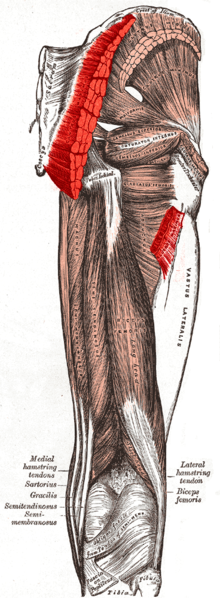Gluteus maximus muscle
Overview
The gluteus maximus is the largest and most superficial of the three gluteal muscles. It makes up a large portion of the shape and appearance of the buttocks.
It is a broad and thick fleshy mass of a quadrilateral shape, and forms the prominence of the nates.
Its large size is one of the most characteristic features of the muscular system in humans, connected as it is with the power of maintaining the trunk in the erect posture.
The muscle is remarkably coarse in structure, being made up of fasciculi lying parallel with one another and collected together into large bundles separated by fibrous septa.
Origin and insertion

It arises from the posterior gluteal line of the ilium, and the rough portion of bone including the crest, immediately above and behind it; from the posterior surface of the lower part of the sacrum and the side of the coccyx; from the aponeurosis of the sacrospinalis, the sacrotuberous ligament, and the fascia (gluteal aponeurosis) covering the gluteus medius.
The fibers are directed obliquely downward and lateralward;
- those forming the lower and larger portion of the muscle, together with the superficial fibers of the lower portion, end in a thick tendinous lamina, which passes across the greater trochanter, and is inserted into the iliotibial band of the fascia lata;
- the deeper fibers of the lower portion of the muscle are inserted into the gluteal tuberosity between the vastus lateralis and adductor magnus.
The gluteus maximus is also a main muscle used in many sports such as volleyball, hockey, basketball, soccer, and football.
Bursae
Three bursae are usually found in relation with the deep surface of this muscle:
- One of these, of large size, and generally multilocular, separates it from the greater trochanter;
- a second, often wanting, is situated on the tuberosity of the ischium;
- a third is found between the tendon of the muscle and that of the vastus lateralis.
Actions
When the gluteus maximus takes its fixed point from the pelvis, it extends the femur and brings the bent thigh into a line with the body.
Taking its fixed point from below, it acts upon the pelvis, supporting it and the trunk upon the head of the femur; this is especially obvious in standing on one leg.
Its most powerful action is to cause the body to regain the erect position after stooping, by drawing the pelvis backward, being assisted in this action by the biceps femoris, semitendinosus, semimembranosus, and adductor magnus.
The gluteus maximus is a tensor of the fascia lata, and by its connection with the iliotibial band steadies the femur on the articular surfaces of the tibia during standing, when the extensor muscles are relaxed.
The lower part of the muscle also acts as an adductor and external rotator of the limb.
See also
External links
- Template:GPnotebook
- Template:MuscleLoyola
- Template:SUNYAnatomyLabs
- Template:ViennaCrossSection
- Template:ViennaCrossSection
- Template:ViennaCrossSection
Template:Muscles of lower limb
cs:Velký sval hýžďový de:Musculus gluteus maximus he:שריר העכוז הגדול fi:Pakaralihas sv:Gluteus maximus Template:Jb1 Template:WH Template:WikiDoc Sources